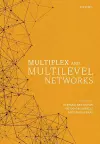
Multiplex and Multilevel Networks
3 contributors - Hardback
£98.00
Stefano Battiston is SNF Professor at the Department of Banking and Finance of the University of Zurich. He holds a PhD in Statistical Physics from École Normale Supérieure, Paris. His work applies the complex networks approach both to the empirical analysis of economic networks and the modelling of their dynamics. For several years, his main interests have been financial contagion, default cascades, and propagation of financial distress, where he combines the insights from the statistical mechanics of networks with the analysis of economic incentives. He has been involved in many international projects, including Forecasting Financial Crises, the first European project aimed at anticipating structural instabilities in the global financial networks. Guido Cadarelli studied Statistical Physics and currently works in the field of Complex Networks. He received his undergraduate degree in 1992 in Rome (La Sapienza) and his PhD in 1996 in Trieste (SISSA). After completing postdocs in Manchester and Cambridge he became firstly "Research Assistant" in INFM and secondly "Primo Ricercatore" at ISC-CNR where he still works as visiting researcher. Presently he is Full Professor of Physics at IMT Lucca and a LIMS Fellow. Since 2015, he has been the Vice-President of the Complex Systems Society. Since 2016, he has been on the board of the SNP Division of European Physical Society. Antonios Garas obtained a PhD in Physics and a Master's degree in Computational Physics from the Aristotle University of Thessaloniki, and is currently a senior researcher at the Chair of Systems Design at ETH Zurich. Having a background in physics with a strong computational training, he has always been interested in pursuing interdisciplinary research. His research combines methods from statistical physics and graph theory, aiming to understand how the properties of a complex system are influenced by the way the systems's components are linked to each other. Using data-driven modeling and state of the art data-mining techniques, he explores applications of his methodology in Economics, Finance, Physics and Sociology.